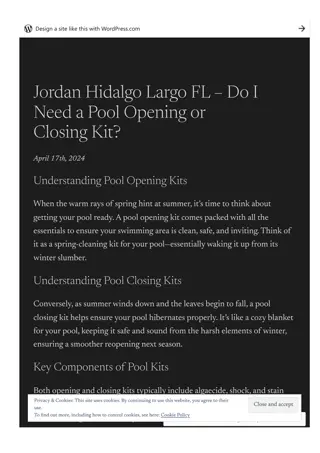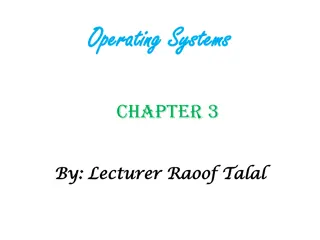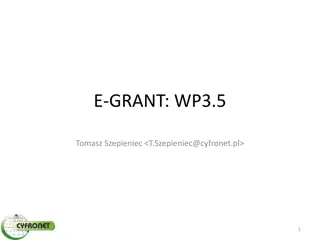Pool Directory: Dynamic Directory Allocation in Many-core Systems
Sparse directory is a critical structure for supporting high-performance coherence tracking in many-core chip-multiprocessors. The proposal introduces a Pool Directory scheme that optimizes directory area, space usage, interconnect traffic, cache misses, and dynamic energy consumption, resulting in significant performance improvements compared to state-of-the-art organizations.
Download Presentation

Please find below an Image/Link to download the presentation.
The content on the website is provided AS IS for your information and personal use only. It may not be sold, licensed, or shared on other websites without obtaining consent from the author.If you encounter any issues during the download, it is possible that the publisher has removed the file from their server.
You are allowed to download the files provided on this website for personal or commercial use, subject to the condition that they are used lawfully. All files are the property of their respective owners.
The content on the website is provided AS IS for your information and personal use only. It may not be sold, licensed, or shared on other websites without obtaining consent from the author.
E N D
Presentation Transcript
Pool Directory: Dynamic Directory Allocation in Many-core Systems Sudhanshu Shukla, Mainak Chaudhuri Indian Institute of Technology Kanpur
Sketch Talk in one slide Result highlights Introduction and motivation Existing proposals and shortcomings Our proposal: Pool Directory Simulation infra-structure Comparison group Simulation results Summary
Sketch Talk in one slide Result highlights Introduction and motivation Existing proposals and shortcomings Our proposal: Pool Directory Simulation infra-structure Comparison group Simulation results Summary
Talk in One Slide Sparse directory is a critical structure for supporting high-performance coherence tracking in many-core chip-multiprocessors Average number of bits per sparse directory entry is an important determinant of the overall directory area, particularly at large core count Our proposal: Each sparse directory entry is provisioned with a short pointer for tracking the owner of a private block; handles the common case because private blocks are more in number than shared blocks Tracking entries for shared blocks are dynamically allocated as needed from a separate direct-mapped pool of short vector entries
Result highlights 128-core chip-multiprocessor running scientific computing, general-purpose, and commercial multi-threaded workloads Our pool directory proposal performs within 2.4% of a full-map bitvector organization at (1/16)x number of entries while investing only one-third space needed by the full-map directory Our proposal performs 5% better than the state- of-the-art SCD organization having equal space Our proposal saves 20% interconnect traffic and 19% private cache misses compared to SCD due to less number of premature directory evictions Our proposal saves 85% dynamic energy in the sparse directory compared to SCD
Sketch Talk in one slide Result highlights Introduction and motivation Existing proposals and shortcomings Our proposal: Pool Directory Simulation infra-structure Comparison group Simulation results Summary
Introduction and motivation Sparse directory is a set-associative tagged structure attached to each last-level cache (LLC) bank Each sparse directory entry tracks the location(s) of an LLC block in the private cache hierarchy attached to each core Sparse directory implementation needs to be space-efficient as the number of cores in the chip-multiprocessor increases For a given number of sparse directory entries, the average number of bits required for tracking a block plays an important role in the total space investment for coherence tracking
Introduction and motivation We present a novel sparse directory organization for optimizing the average number of bits devoted to track a block The width of a sparse directory entry depends on the degree of sharing experienced by a block Typically three types of directory entries are needed Single pointer for tracking a private block Short vector for tracking a few sharers in pointer or bitvector format Large full-map bitvectors for tracking widely shared blocks A single-width full-map bitvector directory entry remains heavily under-utilized on average
Introduction and motivation A full-map bitvector entry is heavily under- utilized on average due to large volume of blocks with low degree of sharing Only 10% of the allocated directory entries observe any sharing for a 2x sparse directory On average only 2.4% bits of a full-map directory entry ever get set
Sketch Talk in one slide Result highlights Introduction and motivation Existing proposals and shortcomings Our proposal: Pool Directory Simulation infra-structure Comparison group Simulation results Summary
Existing proposals and shortcomings Several proposals have recognized the under-utilization of full-map bitvector entries An easy solution is to statically limit the width of the directory entry and sacrifice in terms of the coherence tracking precision e.g., coarse-vector representation Not particularly attractive for low sharing degree Another easy solution is to statically limit the directory entry width, but maintain precision of tracking with limited-pointer representation (good for low sharing degree) Requires costly solutions when tracking information overflows the entry width
Existing proposals and shortcomings Proposals that do not sacrifice tracking precision and do not resort to costly overflow solutions take one of the three forms Static mix of pointer and full-map bitvector entries [Fang et al. PACT 2013] Will be referred to as Hybrid Directory Pointer entries track private blocks and the full- map bitvector entries track shared blocks Static mix of entries (e.g., six pointer ways and two bitvector ways in an eight-way set) makes it difficult to react optimally to different and dynamic mix of sharing degrees of blocks within and across applications
Existing proposals and shortcomings Scalable Coherence Directory (SCD) treats a system having pq cores as a hierarchy of p clusters with each cluster having q cores (q p) [HPCA 2012] Each directory entry has q tracking bits A block with low number of sharers is tracked using a single directory entry in limited-pointer format (up to q/log2(pq) sharers) A block with larger number of sharers is tracked hierarchically using at most p+1 directory entries The root directory entry tracks the clusters Each of the p leaf entries tracks the sharers in a cluster Directory entry width is square root of full-map
Existing proposals and shortcomings Shortcomings of SCD Multiple directory entries are needed to track a block with medium to high degree of sharing Puts pressure on the directory height with increasing sharing degree and number of shared blocks Best case requires two directory entries when all sharers are confined to a single cluster Each directory entry has a tag and therefore, for tracking a block with multiple directory entries, a significant number of bits are devoted to tags In a 1024-core system, with 24-bit tags, a block with 1024 sharers requires at least 33x(32+24) tracking bits, a significant portion of which is invested to tags A private block still wastes a good number of tracking bits in a directory entry
Existing proposals and shortcomings Select Directory attaches just a pointer with each directory entry for tracking the private blocks and dynamically allocates full-map bitvectors from an array of such bitvectors for tracking shared blocks [DATE 2015] When tracking a shared block, the pointer attached to the corresponding directory entry points to the full-map bitvector Advantage: optimized for tracking private blocks and only one tag per block (unlike SCD) Shortcoming: large average wastage when tracking shared blocks Each shared block uses a full-map tracking vector
Sketch Talk in one slide Result highlights Introduction and motivation Existing proposals and shortcomings Our proposal: Pool Directory Simulation infra-structure Comparison group Simulation results Summary
Our proposal: Pool Directory Overview Each sparse directory entry maintains a pointer for tracking private blocks Shared blocks are tracked by dynamically allocating short vector entries from a separate direct-mapped pool of short vectors Each pool entry can use two possible formats for tracking sharers: limited-pointer for tracking a few sharers and segment vector for tracking the sharers if they all fall within a pre-defined cluster of cores Multiple contiguous pool entries can be dynamically allocated to a block for tracking a large number of sharers; each pool entry in such a group can independently use one of the two possible formats The pointer in the sparse directory entry points to the head pool entry of a group (possibly singleton)
Our proposal: Pool Directory Single sharer? Owner pointer/Pool head pointer Occupied bit Head bit
Our proposal: Pool Directory An example in a 128-core system Two 20-bit pool entries encode the six sharers of a shared block (full-map encoding is also shown) Format bit Valid bit Segment/Cluster id
Our proposal: Pool Directory Advantages over SCD-style hierarchical representation Private blocks never contend for pool entries Exactly one tag is allocated for tracking a block The pool entries do not have tags The parent sparse directory entry points to the head pool entry There is no need to maintain a root entry within a group of pool entries tracking a shared block At most p entries are needed for tracking p clusters (as opposed to p+1 in SCD) Each pool entry in a group for tracking a shared block can independently use limited-pointer or segment vector format enhancing compactness
Pool Directory: Adding a sharer The sparse directory lookup leads to three possibilities Miss in directory Hit in directory and single sharer bit is set Hit in directory and single sharer bit is reset Miss in directory Allocate sparse directory entry, set owner in pointer field, set single sharer bit Hit in directory and single sharer bit is set Allocate a pool entry, set head bit of pool entry, set pointer field of directory entry to point to the pool entry, encode two sharers in the pool entry using limited-pointer format, reset single sharer bit in directory entry
Pool Directory: Adding a sharer Hit in directory and single sharer bit is reset Let the new sharer belong to cluster n If the block already has a pool entry encoding sharers in cluster n, that pool entry is used Else if the block has a pool entry using the limited-pointer format that has a free limited- pointer field, that pool entry is used Else the pool entries allocated to the block are examined to see if the new sharer can be accommodated by changing the format of some of the entries For example, if the limited-pointers of a pool entry are encoding sharers belonging to the same cluster, it is better to switch that entry to segment vector format Else a new pool entry needs to be allocated
Pool Directory: Adding a sharer Protocol for adding a new pool entry to a block s set of pool entries Invariant: all pool entries allocated to a block must be contiguous Simplifies design, suffices to have a single head pointer to the set of pool entries for a block The existing set Q of pool entries allocated to a block is grown by one pool entry forward or backward If one of the pool entries before or after Q is free, that entry is allocated Will refer to these two entries as Q_ and Q+ Else one of Q_ and Q+ is evicted to make room for the new allocation
Pool Directory: Adding a sharer Protocol for adding a new pool entry To decide between Q_ and Q+ as the eviction candidate, the following protocol is followed Let each pool entry have enough bits to track all sharers in a cluster of K cores Assuming a total of C cores, a block will need at most C/K pool entries i.e., |Q| C/K The pool is divided into chunks of size C/K entries If Q_, Q, Q+ belong to the same chunk, one of Q_ and Q+ is randomly victimized Else let Q_ belong to chunk C1 and Q+ belong to chunk C1+1; let the number of entries of Q in C1 be N1 and in C1+1 be N2; if N1 N2, Q_ is victimized and otherwise Q+ is victimized Rationale: let Q grow in the chunk where it already has a bigger share so that interference in adjacent chunks is low
Pool Directory: Adding a sharer If the access hits in directory and the single sharer bit is reset, the O and H bits of C/K consecutive pool entries are examined starting from the head entry Reveals the actual number of pool entries allocated to the accessed block The pool is provisioned with two read ports Latency is bounded by C/2K read cycles The worst case latency can be hidden under the LLC access latency at 22 nm process Latency can be improved further via pool banking With C=128 and K=32, 98.6% of directory allocations need at most two pool entries, 99% allocations need at most three pool entries (average latency overhead of reading out a block s pool entry is already low)
Pool Directory: Adding a sharer Protocol for evicting a pool entry A valid pool entry eviction is triggered when addition of a new sharer requires a pool entry Already discussed how the victim pool entry is chosen Selected victim s sparse directory entry is located Each pool entry stores the set index of its sparse directory entry The entire sparse directory set is read out and the pointer fields of all the ways are compared against the head entry index of the collection containing the victim pool entry to locate the correct sparse directory entry If the selected victim is the only pool entry that the sparse directory entry has, all but one sharer tracked by the pool entry are back-invalidated; the spared sharer is tracked in the sparse directory entry Else all sharers tracked by the victim pool entry are back-invalidated
Pool Directory: Adding a sharer Allocation of the first pool entry for a block This is triggered when the number of active sharers of a block reaches two This is handled differently from growing the set of pool entries already allocated to a block Since the set of pool entries allocated to a block must grow contiguously, position of the first pool entry is important to ensure conflict-free growth in future The pool is divided into chunks of size C/K entries and the chunk with a free pool entry is identified by examining the occupied bits Round-robin policy for selecting the chunk with a free pool entry; the load across the chunks is kept uniform If no free pool entry exists, a tail entry is randomly selected from the round-robin chunk
Pool Directory: Removing a sharer A sharer/owner needs to be removed on an eviction hint or writeback from private cache Our protocol generates an eviction hint to the directory whenever a block is evicted from a core s private cache hierarchy The block is located in the sparse directory Removal of the sharer may release a pool entry If the number of sharers drops to one, all pool entries are freed and the sharer is tracked using the pointer field in the sparse directory entry The single sharer bit is set at this point
Sketch Talk in one slide Result highlights Introduction and motivation Existing proposals and shortcomings Our proposal: Pool Directory Simulation infra-structure Comparison group Simulation results Summary
Simulation infra-structure CPU cores Modeled using Multi2Sim 128 out-of-order issue dynamically scheduled x86 cores clocked at 2 GHz iL1 cache: 32 KB, 8-way, 64B blocks, LRU dL1 cache: 32 KB, 8-way, 64B blocks, LRU L2 cache: 128 KB, 8-way, 64B blocks, LRU L2 cache is non-inclusive/non-exclusive with respect to iL1 and dL1 caches Fill on miss; no back-invalidation on eviction L3 cache Shared across all cores, 128 banks (set interleaved), 256 KB 16-way per bank, 64B blocks, LRU
Simulation infra-structure Sparse directory Each L3 cache bank has an eight-way sparse directory slice responsible for tracking the blocks of the bank The number of sets in the sparse directory is expressed as a fraction of the aggregate number of L2 cache sets across all cores Each slice exercises single-bit NRU replacement On-die interconnect 2D mesh, dimension-order routing, single-cycle hop Each hop switch connects a core and an L3 cache bank along with its sparse directory slice
Simulation infra-structure Main memory Eight single-channel DDR3-2133 controllers evenly distributed over the mesh, FR-FCFS scheduling, each controller connects to a 2 GB DRAM module DRAM modules are modeled using DRAMSim2 One rank/channel, eight banks/rank, x8 devices, BL=8, 1 KB row/bank/device, 12-12-12 Applications Drawn from PARSEC, SPLASH-2, SPEC JBB, TPC (running on MySQL server), SPEC Web (running on Apache HTTP server v2.2), SPEC JVM
Sketch Talk in one slide Result highlights Introduction and motivation Existing proposals and shortcomings Our proposal: Pool Directory Simulation infra-structure Comparison group Simulation results Summary
Comparison group SCD [HPCA 2012] (1/16)x sets, 8 ways; each slice has 16 sets and 8 ways; single-bit NRU replacement (skew- associative organization is also evaluated separately) Each entry: valid bit, 31-bit tag, 1-bit coherence state (M/E, shared), 1-bit NRU state, two limited- pointer fields and their valid bits (these 16 bits can also track a cluster of 16 cores in hierarchical representation), two bits for type of entry/ representation (limited-pointer, root, leaf), three bits for cluster id in hierarchical representation Total size: 110 KB
Comparison group Hybrid Directory [PACT 2013] (1/16)x sets, 8 ways; each slice has 16 sets and 8 ways; single-bit NRU replacement Each entry: valid bit, 31-bit tag, 1-bit coherence state (M/E, shared), 1-bit NRU state In a set, six ways can track private owners (seven bits each) and two ways can track shared blocks using full-map vectors (128 bits each) Total size: 142.5 KB
Comparison group Select Directory [DATE 2015] (1/16)x sets, 8 ways; each slice has 16 sets and 8 ways; single-bit NRU replacement Each entry: valid bit, 31-bit tag, 1-bit coherence state (M/E, shared), 1-bit NRU state, 7-bit pointer, 1-bit pointer state (single sharer vs. full- map entry pointer) Each slice has a fully-associative 16-entry table of full-map bitvectors for dynamic allocation to shared blocks; exercises FIFO replacement Each bitvector entry has a 128-bit sharer vector, one valid bit, and four bits of back-pointer to the sparse directory set containing the bitvector s directory entry Total size: 117.25 KB
Comparison group Pool Directory [our proposal] (1/16)x sets, 8 ways; each slice has 16 sets and 8 ways; single-bit NRU replacement Each entry: valid bit, 31-bit tag, 1-bit coherence state (M/E, shared), 1-bit NRU state, 7-bit pointer, 1-bit pointer state (single sharer vs. pool entry pointer) Each slice has a direct-mapped 40-entry pool for dynamic allocation to shared blocks Each pool entry has four limited-pointer fields (7 bits each) and their valid bits (these 32 bits can track the sharers in a 32-core cluster in the segment vector format), occupied (O) and head (H) bits, 1-bit format (limited-pointer/segment vector), 2-bit cluster id, and four bits of back-pointer to the sparse directory set Total size: 109.625 KB
Comparison group Full-map Directory (1/16)x sets, 8 ways; each slice has 16 sets and 8 ways; single-bit NRU replacement Each entry: valid bit, 31-bit tag, 1-bit coherence state (M/E, shared), 1-bit NRU state, 128-bit vector Total size: 324 KB SCD, Select Directory, and Pool Directory are sized to have similar space investment 110 KB, 117.25 KB, 109.625 KB The Pool Directory configuration consumes about one-third space of the full-map directory
Sketch Talk in one slide Result highlights Introduction and motivation Existing proposals and shortcomings Our proposal: Pool Directory Simulation infra-structure Comparison group Simulation results Summary
Message count Pool Directory improves directory space utilization leading to less number of premature eviction of directory entries Compared to SCD, our Pool Directory proposal saves 19% messages Hybrid and Select directories increase message count by 9% and 10%
Message traffic (bytes) Compared to SCD, our Pool Directory proposal saves 20% traffic Hybrid and Select directories increase traffic by 6% and 7%
Sparse directory allocations SCD reduces the directory entry width, but increases the pressure on the directory height significantly Compared to SCD, large savings in sparse directory allocations SCD needs at least two directory entries to track more than two sharers
Private cache misses Pool Directory reduces the number of premature directory entry evictions leading to less number of harmful back-invalidations and private cache misses Hybrid and Select directories are unable to properly track the widely shared code blocks with their resources and suffer from additional code misses Compared to SCD, our Pool Directory proposal saves 19% misses Hybrid and Select directories suffer from 9% and 10% additional misses
Performance comparison Pool Directory performs within 2.4% of full-map on average while investing only one-third space Pool Directory performs 5% better than SCD on average Hybrid and Select directories perform 2% and 4% worse than SCD
Energy and skew-associativity Energy comparison with SCD Pool Directory saves 85% dynamic energy in coherence tracking compared to SCD at 22 nm process (averaged over all applications) Skew-associative organization We model the sparse directory using a four-way skew-associative Z-cache organization employing H3 hashing and three-level timestamp-based LRU replacement (52 replacement candidates) Pool Directory and SCD employ this organization in the sparse directory Pool Directory continues to use a direct-mapped pool Pool Directory performs 4% better than SCD, saves 82% dynamic energy in coherence tracking, and reduces message traffic by 16%
Sketch Talk in one slide Result highlights Introduction and motivation Existing proposals and shortcomings Our proposal: Pool Directory Simulation infra-structure Comparison group Simulation results Summary
Summary A novel sparse directory organization optimizing the average number of bits per tracked block A direct-mapped pool of short vectors is at the heart of the design Each pool entry can track shared blocks in two possible formats: limited-pointer and segment vectors for low to medium sharing degree Multiple contiguous pool entries can collectively track widely shared blocks Pool Directory saves 20% interconnect traffic and performs 5% better than SCD Performs within 2.4% of a full-map organization while requiring only one-third space























